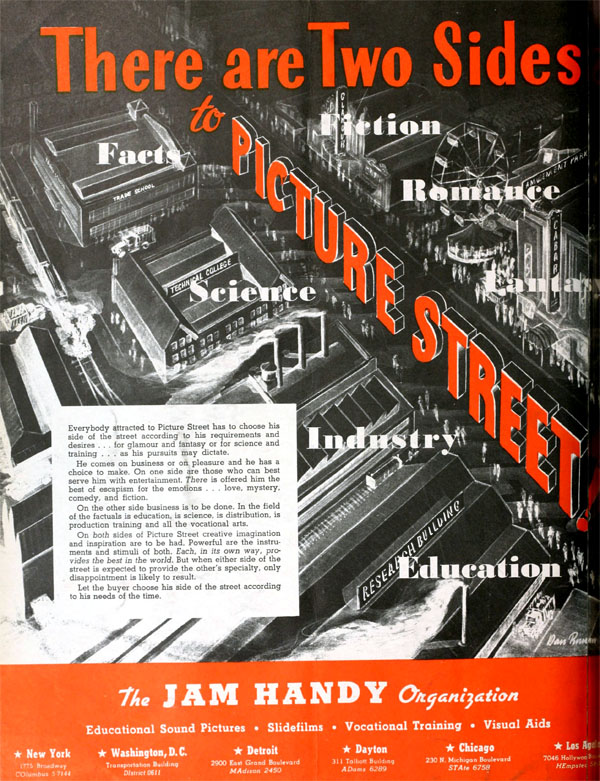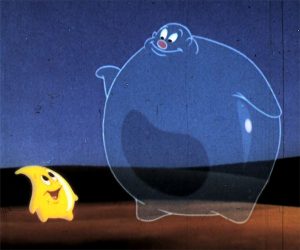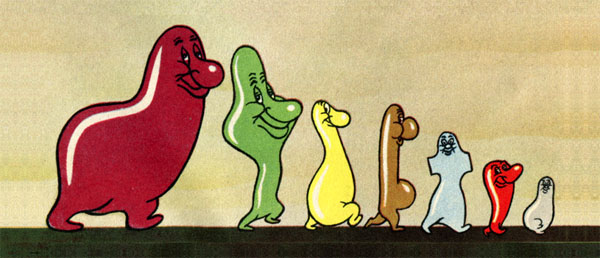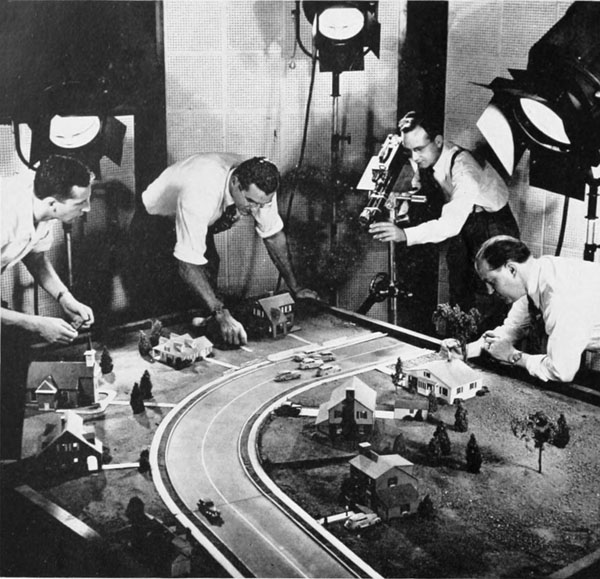
One of my favorite trade ads I’ve stumbled upon while researching the Jam Handy Organization and animated industrial films, is one published by Jam Handy and featured on the back of Business Screen Magazine’s 1942 fifth issue. The ad (above) shows the ‘two sides of picture street’, and (to the author) emphasizes the importance of putting the same high production values and skill used in popular fiction films to educational films, training films, industrial films and other sponsored productions. Today this philosophy is just as important as when conceived by Jamison Handy, as while the technology has changed, the basic communication principals of film/video production, Ethos, Pathos and Logos have not. With the non-stop increasing accessibility of video production and distribution technology (and the reality that it’s not slowing down anytime soon), more and more people are making videos, many of whom are doing so for their work (businesses and non-profits) to demonstrate products, teach skills, etc.
While this is good in many regards, it does have a drawback as due to the speed it’s growing, the education in how to use the medium affectively hasn’t caught up to the same degree or is unknown to many. Fortunately this predicament provides an interesting second life to old industrial films, especially animated films and mixed-media (live-action and animated) productions from the 1930s through the 1960s. Many of the old industrial films produced by Jamison Handy, Jerry Fairbanks, John Sutherland, Raphael Wolff, and others were affective when first made, and they were also inspiring to filmmakers producing low-budget industrial films for their employers.
Today they can be just as inspiring to lower budget video creators, which justifies the importance of rescuing, sharing, and preserving them.
 To further explore what we can learn from yesterday’s industrial cartoons and mixed-media films, let’s briefly revisit and analyze two of my favorites that I’ve written about for Cartoon Research:
To further explore what we can learn from yesterday’s industrial cartoons and mixed-media films, let’s briefly revisit and analyze two of my favorites that I’ve written about for Cartoon Research:
The ABC Of Internal Combustion Engines, (the definitive training film), and…
Gasoline’s Amazing Molecules (aka “The Inside Story of Modern Gasoline” – a prime example of a mixed-media education production in which animation and the use of color both play a key role).
• Animation: Both cartoon animation and technical animation is used to break down and visualize complex ideas in a manner for anyone to understand. Cartoon animation is used to help visualize the concept and entertain viewers, thus making the lesson more interesting and memorable). Technical animation is simple but detailed enough to accurately depict the content in the lesson and eliminate distractions. Consistent and distinctive use of color is also used in the animation to easily identify important components to the content (such as the Kodachrome rainbow of Ken Carbonter’s family of gas molecules).
• Cinematography and layout: While cinematography can be only applied to the live action footage of Gasoline’s Amazing Molecules (which is nicely shot), the animation’s backgrounds to both productions is beautifully laid out and framed, making scenes uncluttered and un-distracting from the lesson.
• Narration: The narration to both films is well written and talks to the viewer in a manner that is easy to understand and also respects them. It’s also enthusiastic about their topics and too the point.
• Music: Both films make use of library music that was composed for the specific film, and is also used in an appropriate manner that enhances the content and entertainment qualities of the lesson (i.e. the cracking dance sequence of the gas molecule in Gasoline’s Amazing Molecules.)

All of these qualities allow these two films and hundreds of others produced during the 1930s through the 1960s to break down a complex subject matter and teach it in a way that is affective and memorable. To put it as Jamison Handy said (in one of the author’s favorite quotes) “learning should be a pleasure, not a pain in the head!” It’s because of these characteristics and philosophies that it’s equally important to study and learn about the Piston Pushing Power Trio and Ken Carbonter’s family of Kodachrome gas molecules to the same degree we study the classics such as Citizen Kane, Casablanca, 12 Angry Men, The Good The Bad And The Ugly, The Graduate, etc. that are commonly showcased in film classes.

“Gasoline’s Amazing Molecules”
That brings us to the second portion of this article, that briefly showcases how the big-budget industrial films and the philosophies of their makers influenced low-budget industrial films from the same era. Many of the big-budget industrials were frequently discussed in professional trade magazines such as Business Screen Magazine and even in film hobbyist club publications such as the Amateur Cinema League’s Movie Makers.
 The reason why these industrial films would be mentioned in film hobbyist club publications was because some of their members were individuals who made low-budget industrial films for their employers. (During this era it was common for American companies such as Ætna Life Insurance, Caterpillar Tractor Company, and the thousands of various factories/manufacturers across the nation to produce or briefly experiment with internally made 16mm films. The people who made these productions, were paid to do so, and were probably 16mm hobbyists whose talents were recognized as more beneficial to the company’s marketing/training departments than on a random assembly line.)
The reason why these industrial films would be mentioned in film hobbyist club publications was because some of their members were individuals who made low-budget industrial films for their employers. (During this era it was common for American companies such as Ætna Life Insurance, Caterpillar Tractor Company, and the thousands of various factories/manufacturers across the nation to produce or briefly experiment with internally made 16mm films. The people who made these productions, were paid to do so, and were probably 16mm hobbyists whose talents were recognized as more beneficial to the company’s marketing/training departments than on a random assembly line.)
Articles in Movie Makers and others discussed techniques in regards to shooting, animation, industrial subjects, philosophy behind making affective teaching films, and would mention successful big-budget films by Jam Handy, etc. as examples. One can imagine that with access to articles from Movie Makers and Business Screen Magazine that these people were able to do their homework and make some ambitious low-budget industrial films that strived to have the same qualities of a big-budget production. Below are three excellent examples of these internal low-budget non-theatrical 16mm productions that were definitely influenced by the animated and mixed-media industrials of the 1930s through the 1960s.

A behind the scenes photo of Live and Let Live.
Live and Let Live (1947) produced and distributed by Ætna Casualty & Surety Company
This 1947 Kodachrome stop motion safe driving film was the twenty-fifth film produced by the ‘Ætna Motion Picture Bureau’ (the filmmaking division of Ætna-Casualty & Surety Company) since it’s establishment in 1940. While it’s stop motion is simple, at times crude and not up to the standards of Ray Harryhausen or Frank Goldman, this ambitious little gem was highly received when released in 1947. ACL’s “Movie Makers” highlighted the production in one of their issues and “Business Screen Magazine” even published a 3/4 page article on the film. A later 1952 Business Screen Magazine article that highlighted Ætna’s film achievements stated this low-budget animated film was selected by the United States Department of State to use overseas and even selected by the Library of Congress for permanent preservation in the library!
Split-Second Shifts by Caterpillar (1958) produced and distributed by Caterpillar Tractor Company
By the 1950s Caterpillar Tractor was producing a large number of internally made 16mm color films to train salesmen and assist in demonstrating products to customers. While the majority of Caterpillar’s internally made films utilized a canned format of nicely shot footage accompanied by enthusiastic narration with a pleasant selection of library music, there were a few exceptions such as this 1958 film. Split-Second Shifts by Caterpillar treats viewers to an ambitious visual mixed-media production utilizing animation, models, and editing effects to demonstrate how Caterpillar’s automatic, clutch-less shifting system works. The use of color plays an important role in the model sequences that demonstrates the mechanics. Overall the entire production looks heavily influenced by the mixed-media films of Jam Handy and Jerry Fairbanks.
Impact: The Story of Metal In Motion (Circa 1960s) produced and distributed by Aluminum Company of America (Alcoa)
This film produced in the early-1960s by Alcoa is a beautifully shot mixed-media demonstration of Alcoa’s ‘impact’ process to customers. While the production features simple technical animation sequences to demonstrate the process, what steals the show are it’s live action sequences reminisce of animated industrial/educational films produced by UPA and John Sutherland. Everything from it’s colorfully shot factory footage, to it’s stylized products/impacts shots, and especially the imaginative Silhouette sequences make this ambitious low-budget industrial almost feel like a stylized cartoon!
In comparing these three low-budget films to the big-budget industrials they all share the production qualities mentioned earlier regarding animation, cinematography, narration, and music and also:
– Taking pride in one’s work,
– Knowing limitations and utilizing available resources,
– Knowing your audience, (and acquiring feedback from them to see what works and does not)
– Appropriate use of library music
– And (to quote Mr. Handy again) “talking to the eye”.
 Whether it’s one of Frank Goldman stop motion epics or Ætna’s ambitious low-budget stop motion production, these productions worked. As showcased above regarding how the big-budget industrials films inspired low-budget live action films, yesteryear’s second side of picture street can still do the same for modern day video makers. As these films worked and were highly praised in trade magazines, they’re excellent and essential to educating a new generation of individuals seeking to use video for distance learning and communicating helpful ideas. And one final note, unlike many of the feature length classics commonly taught in schools, these industrial films are short (ten to thirty minutes) and their public domain status makes them easily and cheaply accessible for study.
Whether it’s one of Frank Goldman stop motion epics or Ætna’s ambitious low-budget stop motion production, these productions worked. As showcased above regarding how the big-budget industrials films inspired low-budget live action films, yesteryear’s second side of picture street can still do the same for modern day video makers. As these films worked and were highly praised in trade magazines, they’re excellent and essential to educating a new generation of individuals seeking to use video for distance learning and communicating helpful ideas. And one final note, unlike many of the feature length classics commonly taught in schools, these industrial films are short (ten to thirty minutes) and their public domain status makes them easily and cheaply accessible for study.
By the way, a lot of the techniques used in these films were also applied to filmstrips of the same era, the precursors to today’s PowerPoint/Keynote presentations… (but that’s a topic for another day.)
Author’s Thanks: The material discussed in this article is accessible due to the hard work of Rick Prelinger (Prelinger Archives), Skip Elsheimer (A/V Geeks), Steve Stanchfield (Thunderbean Animation), Nick Spark (Periscope Film), the late Mike Vraney (Something Weird Video), and the National Film Preservation Foundation. The author is grateful to these individuals and organizations for their hard work to rescuing and sharing these films.


 Jonathan A. Boschen is a professional videographer and video editor, who is also a film and theatre historian. His research deals with pre-1970s movie theaters in New England and also film history pertaining to the Jam Handy Organization, Frank Goldman, Ted Eshbaugh, Jerry Fairbanks, and industrial films. (He is a huge fan of industrial animated cartoons!). Currently, Boschen is working on a documentary on the iconic Jam Handy Organization.
Jonathan A. Boschen is a professional videographer and video editor, who is also a film and theatre historian. His research deals with pre-1970s movie theaters in New England and also film history pertaining to the Jam Handy Organization, Frank Goldman, Ted Eshbaugh, Jerry Fairbanks, and industrial films. (He is a huge fan of industrial animated cartoons!). Currently, Boschen is working on a documentary on the iconic Jam Handy Organization.






















































Shot with a 16mm Kodak Ciné Special I.
The music in the Alcoa film is very Gershwin-like.
Not sure it counts as an industrial film, but I remember a science/health live action/animation called ‘Hemo the Magnificent’, at least I think that’s what it was called. It was about blood, the heart and the human vascular system and Hemo was short for hemoglobin.
Would that fit in this category? It was more school than industrial or military, but a similar style.
That was one of the TV specials directed by Frank Capra for the Bell Telephone Company. UPA, Shamus Culhane and Chuck Jones provide the animation for those.
Hemo the Magnificent was sponsored by the Bell Telephone Company, and was the 2nd in a series of Science Specials initially produced for TV. After the films were aired on TV, AT&T made up countless 16mm prints for school distribution. I first saw Hemo in the 6th Grade in 1965 — I was quite impressed with the production. Later it was issued on VHS and still can be purchased on DVD.